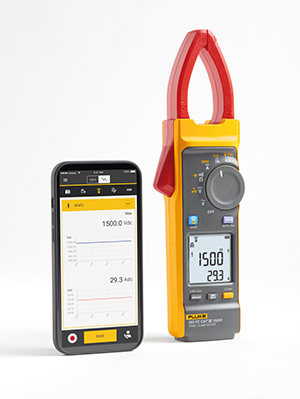

Renewable energy is one of the fastest growing markets in the world. In the UK alone, solar installations have doubled within the last year and are expected to double again by 2030. Rapid expansion of this field is also accelerating the search for ways to reduce risks associated with the installation and commissioning of photovoltaic (PV) systems. The resulting demand for highly accurate hand-held devices capable of carrying out safe and reliable measurements in these applications has now been met with the introduction of the world’s first CAT III 1500 V true-RMS solar clamp meter, the
In PV applications current is not limited by electronics and therefore, choosing the correct solar testing equipment is vital if workers and the PV system itself are to be protected against a range of potential electrical hazards. The
Electrocution
Shock or electrocution from energised conductors can happen when current takes an unintended path through a human body, with lethal results from as little as 50 mA hitting the heart. Electrical shocks are typically caused by a faulty insulation of cables and wiring, damaged insulation of safety covers or improper grounding. The main places such conditions exist in a PV system are the combiner box, the equipment grounding conductor, the PV source and output circuit conductors.
Arc faults and arc flash
Electrical arc faults that spark fires are high-power discharges of electricity between two or more conductors, with the discharge causing heat that can lead to the deterioration or even to burning of wiring insulation. PV systems are particularly vulnerable to arc faults caused by disruption in conductor continuity or by unexpected current between two conductors, often the result of a ground fault.
Arc flash is a phenomenon of large-scale PV arrays that have medium-to-high voltage levels. Only since large-scale solar energy systems have been created has arc flash become a DC issue, which is why arc flash hazard risk analysis must now be carried out on DC systems over 120 V. The issue is particularly prevalent when fault-checking in energised combiner boxes, where PV source circuits are used in parallel to increased current, or when carrying out checks on medium-to-high voltage switchgear and transformers. An arc flash happens when there’s a significant level of energy available to an arc fault in DC and AC conductors. The flash emits hot gases and radiant energy that can be around 19 500 °C. The most at risk set-ups are residential inverters with input voltage up to 500 V and large-scale inverters with an input up to 1500 V. Using a meter that is rated for the relevant measurement category or CAT rating as well as the application’s voltage level is essential so that the meter can cope with average voltage levels and high voltage spikes and transients that are capable of producing shocks or causing an arc flash.
Switching to 1500 V
Most major manufacturers of inverters and solar modules are shifting from 1000 V to 1500 V systems for greater efficiency. For solar installations, overvoltage category
The meter is designed specifically for use by PV installation technicians and maintenance specialists who work in high voltage DC environments. The clamp can measure up to
The clamp is IP54 rated making it well suited to work outdoors, and includes an audio polarity indicator that helps to ensure PV panels are installed correctly.
Polarity functions and audible and visual polarity checks are crucial when commissioning a new site, whether at the combiner box level or inverter level. With a DC polarity check, it’s easy to spot if polarity has been reversed accidentally, avoiding the risk of fires at the combiner box as well as damage to the equipment and danger to personnel.
The Fluke 393 FC meter connects directly to the Fluke Connect software running on a smartphone for logging of all test results. This allows engineers to make and save measurements quickly, with the phone software able to record for 10 minutes and then report readings directly to colleagues. The meter, which also comes with an 18-inch iFlex flexible current probe for extended AC current measurements up to 2500 A, is capable of measuring and recording up to two weeks. All test leads are also rated to
Hans-Dieter Schuessele, application and technology expert EMEA, Fluke said: “Safety is essential when commissioning and installing PV systems. The future of power needs tools that are able to keep you safe in harsh environments. Risk is not an option and you literally have to trust your meter with your life. That’s why the world’s first
| Tel: | +27 10 595 1821 |
| Email: | [email protected] |
| www: | www.comtest.co.za |
| Articles: | More information and articles about Comtest |

© Technews Publishing (Pty) Ltd | All Rights Reserved